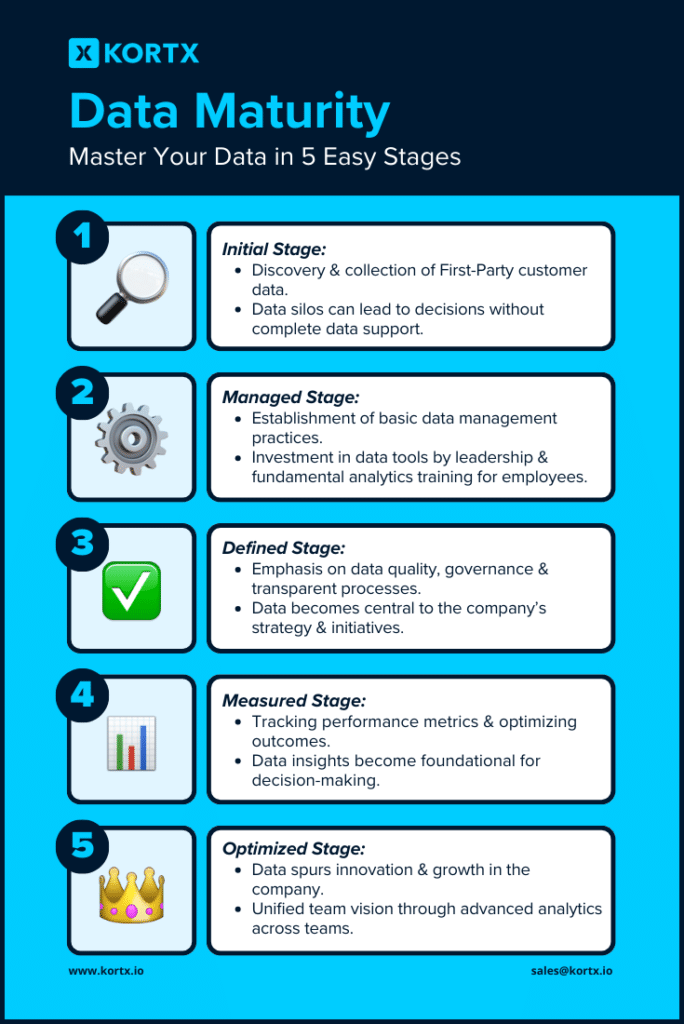When organizations fail to utilize their data fully, they overlook business-critical insights, resulting in less informed decisions and missed opportunities.
With data maturity, you can transform every click, view, and interaction into important insights that inform your marketing strategies.
This article looks into the data maturity model’s various stages, offering insights to help businesses transition from data novices to experts.
⚡ The majority of marketers feel like they either have a novice or intermediate understanding of how to connect their data sources across customer journeys.
What is Data Maturity?
Data maturity measures the sophistication and effectiveness of how a company collects, manages, analyzes, and uses data to guide decisions and strategies.
💡 Research from Heap revealed that data-mature companies achieve 2.5x better business outcomes across the board for revenues and profits, NPS (Net Promoter Score), lifetime customer value (LCV), and overall operational efficiency.
Rather than relying on gut decisions or defaulting to traditional strategies, data-mature companies use qualitative and quantitative data to make decisions about their business.
Example: Netflix collects viewing data from its subscribers using sophisticated algorithms to recommend shows and movies tailored to individual preferences.
Using data maturity in programmatic advertising, your company could analyze the purchasing behaviors of your high-spending customers and then target lookalike audiences with personalized ads. This optimizes ad spend and increases your potential conversion rate as you’re targeting not just any audience but the right one.
The 5 Stages of Data Maturity
A company’s data maturity is characterized by five stages: initial, managed, defined, measured, and optimized. These stages help organizations assess where they stand in their data journey and the steps needed to progress further.
Let’s examine the typical stages of data maturity:
1. Initial Stage
The first stage centers on discovering the customer data at your disposal, also called First-Party data. Data is collected and stored, but you may not understand its potential and have no standardized processes in place for data management.
Within many organizations, silos between teams and functions blur the road toward a unified approach to data maturity. Consequently, each team operates with its interpretation of data best practices, leading to disparities in the way different teams analyze disparate data points using various tools.
At this initial stage of data maturity, decisions are often made without data support, and initiatives lack proper measurement for assessing their impact.
What’s one of the biggest challenges companies have with their data?
“When data is scattered across departments, from marketing to web development, gaining approval and access becomes cumbersome. This misalignment is why many companies don’t utilize their internal data optimally.
For instance, when we need to get a tracking pixel placed on a website for our tool, Axon, and the Media Planner informs us that it’s owned by the Web Dev team, we could end up communicating with multiple stakeholders before we even begin implementing the task.”

2. Managed Stage
As your data maturity journey progresses, you’ll establish basic data management practices. These processes include data collection, storage, and basic reporting. However, there might not be a comprehensive strategy for data utilization, and data remains primarily descriptive.
Your leadership recognizes the value of exploring data-driven tools, improving data utilization, and identifying existing data gaps. Leaders prioritize investments in data collection and management, establishing best practices for roadmap planning and post-launch analysis.
Success metrics are integrated into project briefs and campaigns, and post-mortem analyses become standard. Team members receive fundamental analytics training and access to self-service tools for real-time problem-solving.
3. Defined Stage
You’ll formalize your data strategies during this phase, emphasizing data quality and governance. This involves establishing transparent data management processes and defined roles within the organization, with a central goal of enhancing the reliability and accessibility of your data.
Data takes center stage, driving the core of your strategies and operations. Each initiative is powered by a shared ambition to realize tangible business impact through the prism of data-driven decision-making. Teams are increasingly skilled at harmonizing digital experiences with critical business KPIs, ensuring data is pivotal in every facet of your organization’s endeavors.
What’s one of the biggest challenges companies have with their data?
Collecting, analyzing and understanding your marketing data is critically important so that you can make data-driven decisions. If structured properly, your data will allow you to start focusing on bottom funnel conversion activities to gauge your ROI and CPA rather than focusing on top funnel metrics like CTR and Viewability. It also lays the groundwork for more advanced analysis like Marketing Mix Modeling and creating a single holistic attribution model that attributes credit for each final conversion event or dollar of revenue to the appropriate marketing efforts. By analyzing this data, you can make informed decisions about where to allocate your marketing budget, which channels to focus on, and which strategies are most effective.

4. Measured Stage
The emphasis shifts from data collection to meticulous performance metrics tracking and optimization. It’s about making every piece of data count and extracting maximum value from your information resources.
You’re not just accumulating data; you’re harnessing its potential to unearth valuable insights. These insights become the cornerstone of your strategies, enabling you to make well-informed decisions that drive growth and innovation.
5. Optimized Stage
You’ve reached the pinnacle of data maturity when data becomes a strategic asset driving innovation, customer experiences, and business growth. Advanced analytics and machine learning extract deeper insights, leveraging data to make real-time decisions.
Everyone across your teams looks at the same numbers and dashboards. At this point, your focus shifts to fine-tuning your data strategy.

The Types of Data Collected for Data Maturity
Organizations gather rich, direct, and valuable First-Party data from their audiences throughout their data maturity journey. Using this data is pivotal for successful data maturity.
Some common First-Party data types include:
- Customer Relationship Management (CRM): Contains customer interactions, preferences, and contact details.
- Transactional Data: Records business transactions like purchases, sales, and product and inventory levels.
- Web Analytics: Tracks website traffic, user behavior, and engagement, aiding online optimization.
- Email Campaigns: Measures open rates, click-through rates, and conversions.
- Social Media Data: Involves user interactions, comments, shares, and sentiments for brand monitoring.
- Survey/Feedback Data: Offers insights into customer satisfaction, product feedback, and improvement areas.
- Loyalty Programs: Tracks customer loyalty and rewards program engagement.
- Customer Support Data: Records interactions, identifying customer issues and service improvements.
- App Analytics: Monitors user behavior within mobile apps.
- In-Store Metrics: Analyzes foot traffic, sales patterns, and retailer store performance.
Incorporating First-Party data into your data maturity journey ensures compliance with evolving data privacy norms and offers unparalleled insights into your customer base.
📚 Related Article: What Is First-Party (1P) Data? A Guide to Data-Driven Marketing: First-Party data collection can be overwhelming, so we made this guide to make it easier for you.
Your First-Party Data Should Help You, Not Frustrate You.
Don’t let overwhelming or disorganized data stand in your way. At KORTX, we make it simple. We help businesses like yours uncover valuable insights from their data, leading to smarter strategies and better results.
The Importance of Organization & Cleansing Data
Data organization and cleansing are pivotal to accurate, reliable, and actionable data throughout the data maturity journey.
Let’s explore how these aspects relate to key areas within an organization:
1. Decision-Making
Clean and organized data gives decision-makers the confidence that their choices are based on accurate information.
Example: A programmatic advertising agency utilizes clean data to make real-time decisions on ad placements. Accurate data ensures their bids are strategically placed, maximizing their client’s return on investment (ROI).
2. Personalization and Segmentation
For marketing personalization segmentation and customer engagement, data must be organized to send the right message to the right audience.
Example: An e-commerce platform uses clean customer data to segment users based on their purchase history. This allows them to send personalized product recommendations and tailored ads, increasing customer engagement and sales.
3. Customer Journey Analysis
A well-structured dataset allows organizations to track and analyze the entire customer journey, identifying pain points and opportunities for improvement.
Example: A travel booking platform uses programmatic advertising to re-engage users who abandoned the booking process. Clean data helps track user interactions across devices, allowing them to retarget potential customers with tailored ads and incentives.
4. Compliance
Data cleansing ensures that sensitive customer information is handled in compliance with data protection regulations, reducing the risk of legal and financial repercussions.
Example: An ad tech company ensures that user data used for programmatic advertising complies with GDPR regulations. Clean data practices help them avoid legal issues and fines while maintaining user trust.
5. Efficiency
Clean data streamlines processes and reduces the time and effort required to access and analyze information.
Example: A manufacturing company centralizes its product data in a clean and structured database. This simplifies product information retrieval, streamlines production processes, and accelerates time-to-market.
6. Monetization
Data accuracy and quality are paramount for organizations aiming to monetize their data.
Example: A media publisher leverages programmatic advertising to monetize its website traffic. Clean data on user demographics and behavior allows them to offer highly targeted ad inventory to advertisers, resulting in increased CPM rates and revenue.
Why is data maturity important for companies wanting to run advertising campaigns?
“Data maturity is extremely critical for companies aiming to run successful advertising campaigns. Just having data isn’t enough. Companies have to understand, process, and employ their data in an organized way to target the right audience, craft compelling messages, and allocate budgets efficiently.
A mature data approach makes sure that advertising decisions are rooted in insights rather than assumptions, leading to campaigns that resonate deeply and offer a tangible return on investment.”
Where Will Your Data Go?
The destination of the data maturity journey typically involves aggregating your data back into a centralized system, such as a Customer Relationship Management (CRM) platform or a dedicated database for easy organization. This aggregation is the foundation for further data analysis, visualization, and decision-making.
However, choosing between a CRM and a dedicated database depends on the organization’s complexity, expertise, and specific needs.
1. CRM Aggregation
Aggregating data into a CRM system offers a comprehensive perspective on customer interactions and relationships. This approach is beneficial for organizations prioritizing customer engagement and relationship management.
CRM systems often feature integrated visualization and reporting tools, facilitating easier insight derivation.
Some Examples of CRMs:
- Salesforce: A widely-used cloud-based CRM platform that offers tools for sales, service, marketing, and more.
- HubSpot: Known for its inbound marketing tools, it also offers comprehensive sales and customer service functionalities.
- Zoho CRM: Offers sales automation, marketing automation, analytics, and multichannel communication tools.
- Pipedrive: Focuses on sales management and pipeline management.
2. Database Aggregation
Database aggregation is most suitable for organizations with intricate data demands or those desiring custom analytics. Dedicated databases support advanced analytics, machine learning, and bespoke visualization tools.
These databases allow for enhanced flexibility in terms of data storage and retrieval.
Some Examples of Databases:
- MySQL: An open-source relational database system.
- PostgreSQL: A powerful, open source object-relational database system.
- Redis: An in-memory data structure store used as a database, cache, and message broker.
- Elasticsearch: An open-source search and analytics engine designed for horizontal scalability, reliability, and real-time capabilities.
- Snowflake: A cloud-based data warehousing solution that separates storage and compute resources for scalable and concurrent data operations.
Why is data maturity important for businesses of all sizes?
“The most persistent problem in using data, really for any purpose, is being able to trust that it accurately and reliably represents phenomena that the data is supposed to be capturing. In my experience, the only way to have that trust is to have a program where you understand where you company sits on a data maturity program. You want the maturity of the data program to match the potential value of the data. Otherwise, you run a very real risk of not understanding the risks associated with any given application of the data.
Each company has to do a risk assessment to understand where their particular weaknesses and exposure lies. And then assess if moving up the maturity curve in a particular area is going to mitigate that risk. In the end, I think of it as a cost/benefit thing. If there is substantial financial or reputational risk (or other kinds of risk) that can be mitigated by improving your data maturity, you should do it.”
CRM vs. Database Aggregation
Businesses often choose between CRM systems and dedicated databases, each presenting unique advantages and challenges.
Here’s how the two compare:
Complexity:
- CRM: Typically more user-friendly and ideal for organizations with limited technical expertise or smaller scale.
- Dedicated Databases: Require more technical knowledge but promise increased flexibility.
Scalability:
- CRM: Might encounter challenges handling extensive data volumes.
- Dedicated Databases: Better scalability to cater to growing data needs.
Customization:
- CRM: May face restrictions adapting to distinct data needs.
- Dedicated Databases: Offer broad customization and system integration opportunities.
How to Determine Your Organization’s Data Maturity Stage
Understanding your current position on the data proficiency spectrum is crucial for charting the next steps in your data journey.
To gain clarity, engage with your team with these probing questions:
- Where is your data currently stored for each team?
- What metrics or KPIs do you use to gauge the success of marketing initiatives?
- Is your team able to seamlessly access and analyze data?
- How promptly can they derive insights regarding initiative success?
- Is your team adept at integrating qualitative and quantitative data into their analyses?
Reflecting on these questions will pinpoint your organization’s data maturity and foster a culture of continuous improvement and data-driven decision-making. Remember, the journey to data maturity is iterative and requires regular introspection.
Navigating the Complexity of Data Maturity
Collecting, managing, and successfully using First-Party data can be a challenge for many organizations.
At KORTX, we can assist you in your data maturity journey. We offer a range of services and solutions to help you with your data needs, like helping assess your current data maturity, setting future data-driven goals, and helping bring together different data streams.
With Axon Audience Manager, our advanced customer data platform (CDP), we make it easier for you. Axon combines varied data sources into one cohesive dashboard, enabling you to maximize the full potential of your First-Party data easily.
🔍 Case Study: Trustmark Bank: Discover how the KORTX team leveraged Axon Audience Manager’s First-Party data to identify prime leads, achieving a staggering 98% video completion rate, 90% listen-through rate, and a 0.2% click-through rate.
Data That Works For You
As evidenced by leading companies, high data maturity translates to more informed decisions, heightened business outcomes, and a competitive edge in the market.
Therefore, businesses must assess, nurture, and optimize their data management practices to truly realize the immense data potential and confidently navigate the future. The journey from initial data collection to optimized utilization might be complex, but the rewards are undoubtedly transformative.
Don’t Let Your Data Hold You Back
At KORTX, we’re experts in turning your data into business decisions that matter. If you want to get more from your data without getting lost in the technical details, we’re here to help.
Eric Lee is the Co-Founder and COO at KORTX.


